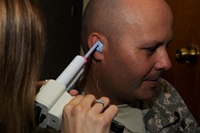Hearing Aids
Hearing aids are electronic devices that pick up and amplify sound. Sounds that the wearer normally would not hear are increased in volume and therefore better delivered to the ear. Technology has paved the way for many innovative hearing devices designed to improve a broad range of hearing impairments.
 Hearing aids are made up of several components that work together to recognize, parse, and amplify sound. The microphone gathers sound and converts it into electrical impulses. A computer chip called the digital signal processor, or DSP, analyzes the incoming sound in order to amplify speech signals and limit unwanted noise. The receiver transforms the electrical impulses back into sound waves and redirects them into the ear. Hearing aids may come with switches that turn the device on or off, allow for telephone usage, or provide volume control.
Hearing aids are made up of several components that work together to recognize, parse, and amplify sound. The microphone gathers sound and converts it into electrical impulses. A computer chip called the digital signal processor, or DSP, analyzes the incoming sound in order to amplify speech signals and limit unwanted noise. The receiver transforms the electrical impulses back into sound waves and redirects them into the ear. Hearing aids may come with switches that turn the device on or off, allow for telephone usage, or provide volume control.
A hearing aid evaluation determines which hearing device is the most appropriate for each patient. The type of hearing aid device best suited to your needs will depend upon many factors. Considerations include:
- Features needed to address patient’s priorities for improved hearing and communication
- The shape of the outer ear
- Depth of depression near the ear canal
- Type and severity of hearing loss
- Manual dexterity to remove and insert hearing aids, and
- Amount of wax build-up in the ear
A few other factors to keep in mind as you choose your hearing aid include:
- Aesthetic considerations
- The hearing aid’s warranty, and
- Health insurance coverage